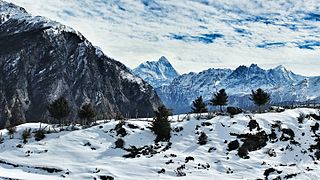Related Research Articles

Kumaon or Kumaun is one of the two regions and administrative divisions of the Indian state of Uttarakhand, the other being Garhwal. It includes the districts of Almora, Bageshwar, Champawat, Nainital, Pithoragarh, and Udham Singh Nagar. It is bounded on the north by Tibet, on the east by Nepal, on the south by the state of Uttar Pradesh, and on the west by the Garhwal region. The people of Kumaon are known as Kumaonis and speak the Kumaoni language.

Garhwal is the western region and administrative division of the Indian state of Uttarakhand. Lying in the Himalayas, it is bounded on the north by Tibet, on the east by Kumaon region, on the south by Uttar Pradesh state, and on the northwest by Himachal Pradesh state. It includes the districts of Chamoli, Dehradun, Haridwar, Pauri Garhwal, Rudraprayag, Tehri Garhwal, and Uttarkashi. The people of Garhwal are known as Garhwali and speak the Garhwali language. The administrative center for Garhwal division is the town of Pauri. The Divisional Commissioner is the administrative head of the Division, and is a senior Indian Administrative Service officer. As the administrative head of the division, the Commissioner is overall incharge of the 7 districts in the Garhwal region of Uttarakhand, and is aided in his duties by an Additional Commissioner and the District Magistrates. Vinod Sharma is currently the Divisional Commissioner of the Garhwal Division.

The Northern Indo-Aryan languages, also known as Pahāṛi languages, are a group of Indo-Aryan languages spoken in the lower ranges of the Himalayas, from Nepal in the east, through the Indian states of Uttarakhand and Himachal Pradesh, reaching as far west as the Jammu region of Jammu and Kashmir. The name Pahari is Grierson's term.

Bhotiya or Bhot are groups of ethno-linguistically related Tibetan people living in the Transhimalayan region that divides India from Tibet.. The word Bhotiya comes from the classical Tibetan name for Tibet, Bod. The Bhotiya speak numerous languages including Ladakhi. The Indian recognition of such language is Bhoti / Bhotia having Tibetan scripts and it lies in the Parliament of India to become one of the official languages through Eighth Schedule of the Indian Constitution.

Uttarakhand, formerly known as Uttaranchal, is a state in the northern part of India. It is often referred to as the "Devabhumi" due to numerous Hindu temples and pilgrimage centres found throughout the state. Uttarakhand is known for the natural environment of the Himalayas, the Bhabar and the Terai regions. It borders the Tibet Autonomous Region of China to the north; the Sudurpashchim Pradesh of Nepal to the east; the Indian states of Uttar Pradesh to the south and Himachal Pradesh to the west and north-west. The state is divided into two divisions, Garhwal and Kumaon, with a total of 13 districts. The winter capital of Uttarakhand is Dehradun, the largest city of the state, which is a rail head. Gairsain, a town in Chamoli district is the summer capital of Uttarakhand. The High Court of the state is located in Nainital.

Kumaoni (कुमाऊँनी) is an Indo-Aryan language spoken by over 2 million people of the Kumaon region of the state of Uttarakhand in northern India. Along with neighbouring Garhwali, it belongs to the Central Pahari languages, a group normally classified within the Northern Indo-Aryan group.

Garhwali (गढ़वळि) is an Indo-Aryan language of the Central Pahari subgroup. It is primarily spoken by over 2.5 million Garhwali people in the Garhwal region of the northern Indian state of Uttarakhand in the Indian Himalayas.

Mahakali was one of the fourteen zones located in the Far-Western Development Region of Nepal, covering an area of 6,205 km2 in the most western part of the country. It stretches along Nepal's far western border with India, marked by the Kali River or Mahakali River.

Pithoragarh is the easternmost district in the state of Uttarakhand, India. It is located in the Himalayas and has an area of 7,110 km2 (2,750 sq mi) and a population of 483,439. The city of Pithoragarh, located in Saur Valley, is its headquarters. The district is within the Kumaon division of Uttarakhand state. The Tibet plateau is situated to the north and Nepal is to the east. The Kali River is formed by the joining of two headwaters near Gunji and flows south, forming the eastern border with Nepal. The Hindu pilgrimage route for Mount Kailash-Lake Manasarovar passes through this district via Lipulekh Pass in the greater Himalayas. The district is administratively divided into six tehsils: Munsyari; Dharchula; Didihat; Berinag; Gangolihat; and Pithoragarh. Naini Saini Airport is the nearest civil airport, but it does not have regular scheduled commercial passenger service. The mineral deposits present in the district are magnesium ore, copper ore, limestone and slate. There are 11 tehsil.
Bhoksa, also known as Buksa, are indigenous peoples living mainly in the Indian states of Uttarakhand and Uttar Pradesh. They are mostly concentrated in Dehradun and Nainital districts in the foothills of the outer Himalayas. They are also found in the Bijnor district of Uttar Pradesh, where they are known as Mehra. Both communities have been granted Scheduled Tribe status.
Uttarakhand, India. Literally Northern Land or Section in Sanskrit, the name of Uttarakhand finds mention in the early Hindu scriptures as the combined region of Kedarkhand and Manaskhand.
The Tharu or Tharuhat languages are any of the Indo-Aryan languages spoken by the Tharu people of the Terai region in Nepal, and neighboring regions of Uttarakhand, Uttar Pradesh and Bihar in India.
Bhotiyas are people of presumed Tibetan heritage that live along the Indo-Tibetan border in the upper reaches of the Great Himalayas, at elevations ranging from 6,500 feet (2,000 m) to 13,000 feet (4,000 m). In Uttarakhand, they inhabit seven river valleys, three in the Garhwal division and four in the Kumaon division. Their main traditional occupation is Indo-Tibetan trade, with limited amounts of agriculture and pastoralism. They follow Hinduism and Buddhism and traditionally speak West Himalayish languages, which are slowly getting replaced by the predominant Indo-Aryan languages of the region.
Raji is a small Sino-Tibetan language of Nepal and Uttarakhand, India. Speakers were recently nomadic.
Byangsi is a West Himalayish language of India and Nepal. Estimates of numbers of speakers vary, but some sources say that the language is spoken by about 1,000-1,500 people, while others estimate as many as 3,300. Byangsi is from a region of high language density, that is to say that there are many languages among few people. It is the most dominant language in this region, although it is not widely known outside of its small hill district and those who speak it have difficulty classifying themselves for central government dealings.
Rongpo or Rangpo is a West Himalayish language spoken in Uttarakhand, India.
Chaudangsi is a Sino-Tibetan language spoken in the Indian state of Uttarakhand.
Darmiya or Darma is a Sino-Tibetan language spoken in the Darma Valley, Dharchula Tehsil, Pithoragarh District of the Indian state of Uttarakhand. It is one of the fifteen tribes, as stated in The Constitution Uttar Pradesh Order, 1967 in clause (1) of Article 342 of the Constitution of India. Majorly it is called Bhotia; Bhotia is the broad term used in Himalayan region: several communities and languages are considered under this term. This tribal language is the member of west Tibeto-Burman language family in the Himalayan region of Uttarakhand. It is related to Rangas, Rongpo, Chaudangsi, and Byangsi. Alternate names for this language include Darma, Darma Lwo, Darma-Lwo, Darmani, Saukas, and Shaukas.

Jaunsari is a Western Pahari language of northern India spoken by the Jaunsari people in the Chakrata and Kalsi blocks of Dehradun district in the Garhwal region of Uttarakhand state.

Nepali is an Indo-Aryan language of the sub-branch of Eastern Pahari. It is the official language of Nepal and one of the 22 scheduled languages of India. Also known by the endonym Khas kura, the language is also called Gorkhali or Parbatiya in some contexts. It is spoken mainly in Nepal and by about a quarter of the population in Bhutan. In India, Nepali has official status in the state of Sikkim and in the Darjeeling Sadar subdivision and Kalimpong district of West Bengal. It has a significant number of speakers in the states of Arunachal Pradesh, Assam, Himachal Pradesh, Manipur, Mizoram and Uttarakhand. It is also spoken in Myanmar and by the Nepali diaspora worldwide. Nepali developed in proximity to a number of Indo-Aryan languages, most notably the other Pahari languages and Maithili and shows Sanskrit influence. However, owing to Nepal's location, it has also been influenced by Tibeto-Burman languages. Nepali is mainly differentiated from Central Pahari, both in grammar and vocabulary, by Tibeto-Burman idioms owing to close contact with this language group.
References
- ↑ Hammarström, Harald; Forkel, Robert; Haspelmath, Martin, eds. (2017). "Rangkas". Glottolog 3.0 . Jena, Germany: Max Planck Institute for the Science of Human History.
- ↑ Ethnologue entry for Rangas
| This Sino-Tibetan languages-related article is a stub. You can help Wikipedia by expanding it. |
| This article about the culture of India is a stub. You can help Wikipedia by expanding it. |